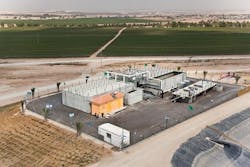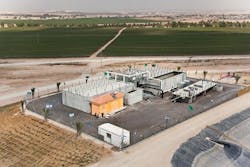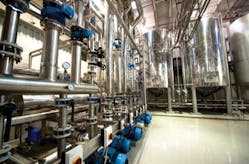Following effluent quality parameter improvement, Israel is a leading water reuse nation across the Middle East. As this story demonstrates, even farmers are inspired and taking matters into their own hands. Don McCarty looks at how an effluent reuse system has helped restore life back to the Negev region.
Be'er Sheva, one of Israel's largest cities with a population of approximately 200,000, is located in the country's Negev Desert in the southern portion of the country. The entire Negev region, which is located just to the east of the Sahara Desert, is extremely arid, with parts of the desert receiving just over an inch of rain per year.
The lack of rain has only worsened in recent years, as Israel has experienced its worst water shortage on record. Seven consecutive years of drought, coupled with increased demand from a growing population, have led to the overexploitation of the country's water supply. In fact, water shortages have long been a serious problem for much of the region.
While 5% of the world's population resides in the Middle East and North Africa, the region has less than 1% of the world's available water supply. As a result, the people of Israel and other nearby countries have long sought innovative ways to use every available drop of water. The reuse of treated wastewater effluent has become a common strategy in the region, especially for agricultural irrigation purposes.
Farming innovation
For the farmers of the Negev Settlements, a cooperative union of 34 settlements outside of Be'er Sheva, the gradual replacement of freshwater sources couldn't happen quickly enough.
No suitable source of water was available to irrigate their crops – primarily potatoes, corn, wheat and cotton.
In order to provide the tertiary filtration necessary for unrestricted irrigation, the farmers pooled their resources and paid for the construction of an effluent reuse system next to the wastewater treatment plant. The idea was that effluent from the plant would be treated through the reuse system and then pumped to the fields.
The selected filtration system's treatment capacity is 60,000 m3/day with 90% of the effluent used for agricultural irrigation and 10% for irrigation of Be'er Sheva's municipal parks. In addition to the new filtration technology, a UV system is used downstream for disinfection purposes.
Water reUSE: PROCESS details
The selected technology was the TETRA DeepBed Filter comprising six cells, each 17.07 m in length and 2.9 m wide, providing a total area of 300 m2. The filtration system uses 900 tons of TETRA #5 quartz sand media and 2,500 TETRA SNAP T underdrain filter blocks. An underdrain system is required to support filter media and to separate the filter media from the bottom of the filter.
In addition to providing support for the filter media, the underdrain system serves two primary purposes: to allow filtered water to pass through to the collection system and to start the distribution of backwash water and backwash air across the filter.
So how does it work? The SNAP T Block features interlocking blocks with a snap-locking mechanism that enhances block stability during backwash procedures. Additional passive interlocking as well as positive row spacing maintains a uniform opening, 0.635 cm between the blocks for improved backwashing distribution. Unlike traditional underdrain designs that rely on a high pressure differential across the block to distribute backwash water, there is virtually no pressure drop across the SNAP T Block.
Traditional underdrains often use small orifices or nozzles with small screen openings (strainer systems) in order to create a pressure differential that will evenly distribute backwash water and air. Underdrains with such small openings can be vulnerable to blockage by solids and biofilm growths, which makes them especially unsuitable for wastewater applications such as Be'er Sheva.
Instead of using a high pressure differential to distribute backwash air, the SNAP T Block uses an independent positive backwash air distribution system with an air header and laterals protected under the block. The laterals contain evenly spaced air openings every 10.6 cm, which enhances the backwash water distribution.
When backwash air is introduced into a traditional plastic underdrain system, the underdrain block becomes buoyant, and special precautions must be taken to prevent underdrain failure during routine backwash conditions and during hydraulic shocks. The SNAP T Block is a plastic-jacketed, concrete-filled block weighing more than 22 kilograms (50 pounds), and is not buoyant under backwash conditions.
The SNAP T Block allows the weight of the entire filter underdrain to counteract the upward forces of the backwash. It can also handle significant downward forces, including up to eight meters of media. Furthermore, the SNAP T Block prevents gravel from entering the underdrain system while allowing filtrate to pass to the filter discharge location. The floor has no nozzles or small orifices that can lead to blockage by biofouling. Since biofouling is not an issue, chlorine addition during backwashing is not required.
The filtration plant operates as a single filter consisting of a number of cells into which the influent flow is distributed. Flow passes through the media and suspended solids are removed. Filtered effluent is discharged through a clear well which retains a reservoir of water for cell backwashing. As the size of the media used is larger than the size of the solids targeted for removal, solids can penetrate deep into the bed. As the upper layers of media voids begin to fill with solids, the velocity through these restricted pore spaces must increase in order to pass the same quantity of flow.
The filter is "regenerated" by taking one cell offline at a time and employing an air and water backwash to clean the media. Dirty backwash water generated (typically 1% to 3% of forward flow for design solids loadings) is returned to the treatment works. While a cell is offline for backwashing, the influent flow is redistributed to the other cells, and operation of the filter continues with minimal impact on the quality of the effluent.
TSE Reuse DriversIn 2000, the Knesset, Israel's parliament, set in motion the establishment of stringent regulations to upgrade effluent standards. The objective was to eventually treat 100% of the country's wastewater to a level enabling unrestricted irrigation in accordance with soil sensitivity and without risk to soil and water sources. More recently, in January 2010, the Interior and Environmental Protection Committee of the Knesset approved regulations that would upgrade the 1992 minimal standard of 20 ppm biological oxygen demand (BOD) and 30 ppm total suspended solids (TSS) to 10 ppm BOD and 10 ppm TSS. Additionally, the regulations established 35 new effluent quality parameters with maximum permissible levels for each. The legislation called for the gradual replacement of freshwater allocations to agriculture by reclaimed effluents through the upgrade of all wastewater treatment plants to tertiary treatment. Since 2000, the use of treated wastewater for irrigation by the agricultural sector has increased from 17% of water consumed by the sector to more than 50%. |
Although most filters employ some type of regenerative backwash, the TETRA system typically requires significantly less consumption of forward flow, and subsequently, less generation of dirty backwash water that needs to be treated.
Facility results
The new filtration plant was commissioned in April 2011 and the system was designed to produce an effluent turbidity of 2 NTU. Effluent turbidity measures an average of 0.7 NTU and the effluent TSS concentration averages 2.5 mg/L. With this set up coagulant or flocculent is not required during filtration to produce the required effluent quality.
With the performance of filtration technology, the farmers or the Negev region are happy. Ten thousand acres of desert have literally been turned into beautiful, green, productive farmland.
Author's note:Don McCarty is senior process engineer, Water Purification Group, Severn Trent Services
More Water & WasteWater International Current Issue Articles
More Water & WasteWater International Archives Issue Articles







